
eBook - ePub
The Unity of the Universe
D. W. Sciama
This is a test
Partager le livre
- 256 pages
- English
- ePUB (adapté aux mobiles)
- Disponible sur iOS et Android
eBook - ePub
The Unity of the Universe
D. W. Sciama
Détails du livre
Aperçu du livre
Table des matières
Citations
À propos de ce livre
Does the universe consist of independent objects, or is it a single unit? Are some of its features accidental, or can they all be explained in theoretical terms? This accessible book on cosmology addresses profound questions about the universe, and it offers elegant answers in simple, straightforward terms. Written by a distinguished cosmologist, it assumes no knowledge of physics or astronomy and illustrates its explanations with figures and compelling photos.
The first part ventures back to the early Greek astronomers, who were the first to measure the Earth's size and the distance to the sun and the moon. It also examines the latter-day discoveries of distant galaxies, achieved with giant telescopes and mathematical calculations. The second part explores modern theories, including the author's own conviction that the universe is a single unit and that the behavior of nearby matter is strongly influenced by distant regions of the universe. A student of Fred Hoyle and Paul Dirac and a teacher of Stephen Hawking, D. W. Sciama is best known for his work on general relativity and black holes. Scientific American acclaimed his survey as `an engrossing book` and `an invigorating intellectual exercise that any mature reader can enjoy.`
The first part ventures back to the early Greek astronomers, who were the first to measure the Earth's size and the distance to the sun and the moon. It also examines the latter-day discoveries of distant galaxies, achieved with giant telescopes and mathematical calculations. The second part explores modern theories, including the author's own conviction that the universe is a single unit and that the behavior of nearby matter is strongly influenced by distant regions of the universe. A student of Fred Hoyle and Paul Dirac and a teacher of Stephen Hawking, D. W. Sciama is best known for his work on general relativity and black holes. Scientific American acclaimed his survey as `an engrossing book` and `an invigorating intellectual exercise that any mature reader can enjoy.`
Foire aux questions
Comment puis-je résilier mon abonnement ?
Il vous suffit de vous rendre dans la section compte dans paramètres et de cliquer sur « Résilier l’abonnement ». C’est aussi simple que cela ! Une fois que vous aurez résilié votre abonnement, il restera actif pour le reste de la période pour laquelle vous avez payé. Découvrez-en plus ici.
Puis-je / comment puis-je télécharger des livres ?
Pour le moment, tous nos livres en format ePub adaptés aux mobiles peuvent être téléchargés via l’application. La plupart de nos PDF sont également disponibles en téléchargement et les autres seront téléchargeables très prochainement. Découvrez-en plus ici.
Quelle est la différence entre les formules tarifaires ?
Les deux abonnements vous donnent un accès complet à la bibliothèque et à toutes les fonctionnalités de Perlego. Les seules différences sont les tarifs ainsi que la période d’abonnement : avec l’abonnement annuel, vous économiserez environ 30 % par rapport à 12 mois d’abonnement mensuel.
Qu’est-ce que Perlego ?
Nous sommes un service d’abonnement à des ouvrages universitaires en ligne, où vous pouvez accéder à toute une bibliothèque pour un prix inférieur à celui d’un seul livre par mois. Avec plus d’un million de livres sur plus de 1 000 sujets, nous avons ce qu’il vous faut ! Découvrez-en plus ici.
Prenez-vous en charge la synthèse vocale ?
Recherchez le symbole Écouter sur votre prochain livre pour voir si vous pouvez l’écouter. L’outil Écouter lit le texte à haute voix pour vous, en surlignant le passage qui est en cours de lecture. Vous pouvez le mettre sur pause, l’accélérer ou le ralentir. Découvrez-en plus ici.
Est-ce que The Unity of the Universe est un PDF/ePUB en ligne ?
Oui, vous pouvez accéder à The Unity of the Universe par D. W. Sciama en format PDF et/ou ePUB ainsi qu’à d’autres livres populaires dans Physical Sciences et Cosmology. Nous disposons de plus d’un million d’ouvrages à découvrir dans notre catalogue.
Informations
Sujet
Physical SciencesSous-sujet
CosmologyPART I
THE UNIVERSE IN OBSERVATION
INTRODUCTION
The naked eye can distinguish the earth, the sun, the moon, the comets, five planets, and six thousand stars. This was man’s picture of the universe until 1609, when Galileo first pointed a telescope at the sky. With this instrument he extended our knowledge by observing many stars which are too faint to be seen directly. Thereafter, each increase in size of telescope has revealed the existence of still fainter stars. This has prompted many people to ask the question: Will this process ever stop? Have we any chance of discovering, if not every star, at least the main outlines of the whole universe? Most astronomers believe that with the best modern telescopes they have indeed done just this.
The first reaction to this claim will perhaps be one of excitement that such a fundamental result should have been achieved in our own lifetime. Nevertheless, we must remember that often in the past fundamental scientific problems have wrongly been considered solved. The great French mathematician Lagrange, for instance, was envious of Newton’s good fortune: “for in his time the system of the world still remained to be discovered.” And toward the end of the nineteenth century most physicists believed that there was nothing left for them to do, except to calculate known quantities to more and more decimal places.
Are modern astronomers any more likely to be right than were their eminent predecessors? Despite the danger of saying so, they believe the answer to be “Yes.” There is a special reason for believing that the twentieth-century universe is the universe; that further discoveries will add much in detail but will not alter the general picture. This reason will begin to emerge at the end of Part I, but in order to prepare for it we must go back to the early Greek astronomers, who were the first to measure the size of the earth and the distance to the sun and the moon—thus providing man with his first orientation towards the dimensions of the universe.
These early measurements, and their modern counterparts, are described in Chapter I. The subsequent chapters show how the more powerful methods introduced in the last hundred and twenty years have extended our knowledge of distances from the solar system to the stars, and from the stars to distant galaxies. This knowledge has played a key role in the elucidation of what is our goal in these chapters—the structure of the universe as a whole.
CHAPTER I
THE SIZE OF THE SOLAR SYSTEM
Ah, but a man’s reach should exceed his grasp,
Or what’s a heaven for?
Or what’s a heaven for?
BROWNING
Introduction
It is not surprising that it was the Greeks, with their profound understanding of geometrical principles, who were the first to devise methods of measuring the size of the earth and the distance to the sun and the moon. Indeed, their results were not superseded until the eighteenth century, when telescopes had been developed to the point where new methods could be introduced. We shall therefore begin our account of the universe in observation by going back to Greek astronomy.
Greek Times
THE SIZE OF THE EARTH. A rough estimate of the size of the earth was made by Aristotle, but we owe the first accurate value to Eratosthenes (276–194 B.C.). He found that when the sun is overhead at Aswan it is 7 degrees from the vertical in Alexandria (Fig. 1a). This simple observation suffices to determine the circumference of the earth in terms of the distance from Aswan (A) to Alexandria (B) (Fig. 1b). For since the sun is at a great distance from the earth, the angle of 7 degrees measured by Eratosthenes is very nearly the same as the angle AOB subtended by the arc AB at the center of the earth O. Now since 7 degrees is nearly one fiftieth of a complete revolution of 360 degrees, the distance between Aswan and Alexandria must be nearly one fiftieth of the circumference of the earth. Eratosthenes knew that this distance is about 500 miles, so he deduced that the circumference of the earth is about 25,000 miles. This early value differs by less than 200 miles from the one now accepted.
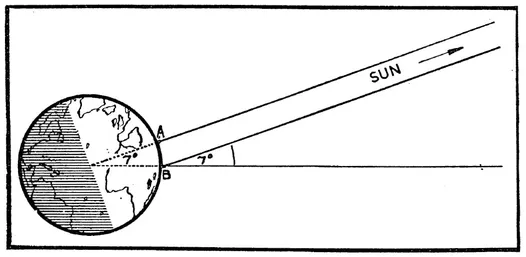
Fig. 1. (a) Eratosthenes’ method of measuring the earth’s circumference. When the sun is directly overhead at A, it makes an angle of 7 degrees with the vertical at B.
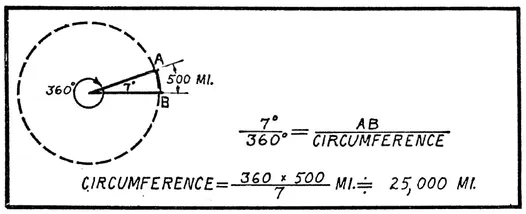
(b) Calculation of the earth’s circumference.

Fig. 2. Aristarchus’ method of measuring the distance of the moon. (a) A partial eclipse of the moon. (b) The angular diameter of the sun as seen from the earth. (c) The angular diameter of the earth’s shadow at the disThe angular diameter of the earth’s shadow at the distance of the moon. (d) Construction for determining the moon’s distance from the earth.
THE DISTANCE AND SIZE OF THE MOON. The first man to propose a method of measuring the distance to the moon appears to have been Aristarchus of Samos, who lived in the third century B.C. So slow was the development of science at that time, however, that his method was not used for another hundred and fifty years. It was then taken up by the great astronomer Hipparchus, who succeeded in obtaining a very accurate value. The method consists of the following steps (Fig. 2):
(i) Measurement of the angle subtended by the sun at the earth—that is, the sun’s angular diameter (Fig. 2b). This angle is about ½ degree.
(ii) Measurement of the angular diameter of the earth’s shadow at the distance of the moon (as observed at a partial eclipse of the moon). (Fig. 2c. ) This angle is about 1 degree.
These observations suffice to determine the distance of the moon in terms of the earth’s diameter. It can be calculated by trigonometry or measured by means of the following simple geometrical construction. Draw the shadow of the earth as shown in Fig. 2d. Since the sun is very distant, the edges of the shadow meet at nearly the same angle as that subtended by the sun–that is, ½ degree (Fig. 2a). Now draw in at the earth the angle of 1 degree determined in Step (ii). This angle must intersect the edge of the shadow at the position of the moon (Fig. 2d). We can then measure the distance of the moon in terms of the earth’s diameter.
Hipparchus’ observations imply that the distance of the moon is 30 earth diameters. Using Eratosthenes’ value for the size of the earth, Hipparchus calculated that the moon is 240,000 miles away, a result which is within 1000 miles of the correct one.2 We are here faced with a distance so much greater than any we are familiar with on earth that it is inconvenient to measure it in terms of miles. We shall use instead a modern unit, namely the time taken by light to travel the distance involved. Hipparchus’ result implies that it takes light about 1¼ seconds to reach us from the moon—so the distance to the moon is 1¼ light-seconds.
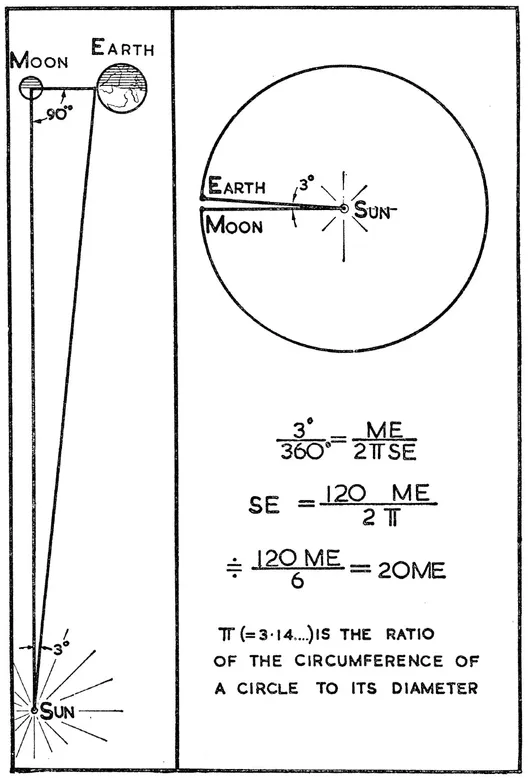
Fig. 3. Aristarchus’ method of measuring the distance of the sun. (a) The earth-sun-moon system when the moon is half illuminated (“first quarter”). (b) Calculation of the sun’s distance from the earth.
Hipparchus was now in a position to determine the diameter of the moon. He simply measured its angular diameter, which is about ½ degree. The ratio of this angle to 360 degrees leads to a value for the moon’s diameter of 2000 miles, which is a quarter of the earth’s diameter.
In passing we may comment on a fact which the reader may have already noticed: that the moon’s angular diameter is very nearly the same as the sun’s. This is a very fortunate fact for astronomers, since it means that at a total eclipse of the sun the moon is just the right size to blot it out completely. When this happens we can see the outer extensions of the sun -its corona—which are too faint to be seen when the sun is shining (Plate I). Had the moon’s angular diameter been smaller than the sun’s we should not be able to see the corona at an eclipse, and solar astronomy would have lost an important source of information.
THE DISTANCE AND SIZE OF THE SUN. The first attempt to measure the distance to the sun also appears to have been made by Aristarchus. His method shows as much ingenuity as the one he suggested for measuring the distance to the moon, but it is far less accurate. It consists in measuring the angular separation between the moon and the sun at the moment of so-called “first quarter,” when the moon is half illuminated (Fig. 3a).
In this figure the angle EMS is one right angle, go degrees. Since the sun S is much farther away from the earth than is the moon M, the angle MES will be very nearly go degrees. Aristarchus measured this angle and obtained the value 87 degrees. It follows from this that the angle MSE is 3 degrees (since the sum of the angles of a triangle is two right angles). We can now relate the distance SE to the distance ME, as shown in Fig. 3b. Aristarchus deduced in this way that the sun is about 20 times farther from the earth than is the moon. Since Hipparchus’ value for the distance to the moon is 240,-000 miles, we see that according to Aristarchus’ measurement the distance to the sun is 4,800,000 miles, or 26 light-seconds.
From this estimate of the sun’s distance we can also determine its diameter, since its angular diameter is ½ degree. In fact, since the angular diameter of the sun is the same as that of the moon, their diameters are in the same ratio as their distances (Fig. 4). According to Aristarchus, then, the sun’s diameter is 40,000 miles.
Actually both these estimates are very bad approximations to the truth. The reason is that Aristarchus’ method is very sensitive to an error in the measurement of the angle MES.
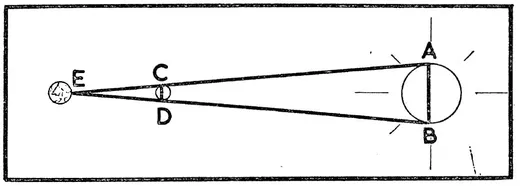
Fig. 4. Calculation of the sun’s diameter. By similar triangles, the diameters of the sun and moon are in the same ratio as their distances.
For suppose that he had obtained a value of 89 degrees instead of 87 degrees—an error of only 2 per cent. In that case the angle ESM would be 1 degree. This is one third of the angle of 3 degrees actually obtained by Aristarchus, and it would imply that the sun is 60 times farther than the moon. Thus an error of only 2 per cent in the measured angle leads to an error of a factor 3 in the inferred distance to the sun. Aristarchus’ error was in fact greater still, since the sun is actually about 400 times farther away than the moon. But this was not discovered till much later—Aristarehus’ value was the accepted one for eighteen hundred years. Not until the eighteenth century was a better value obtained.
Modern Times
THE DISTANCE TO THE MOON. The first modern attempt to determine the distance to the moon was made by the amateur astronomer Abbé Nicholas Louis de la Caille (1713-62). He succeeded in measuring the parallax of the moon. Parallax is a very important concept in astronomy; it arises from the fact that an object looked at from different places appears to lie in different directions. In Fig. 5 the angle P is known as the parallax of the object relative to the given base line AB; it is smaller the farther away the object is. Another way of describing it is to say that it is the angle subtended by the base line at the object. Its importance to astronomy arises from the fact that, if it can be measured relative to a base line of known length, the distance to the object can be calculated by simple trigonometry.
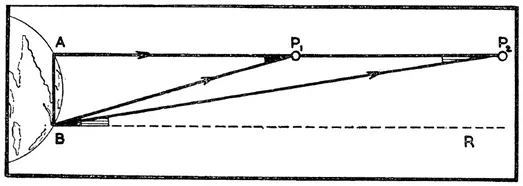
Fig. 5. Parallax. An objects looked at from different places appears to lie in different directions. Here the parallax of P1 relative to AB is the angle P1BR. This is equal to the angle AP1B, which is the angle subtended by the base line AB at the object P1. Note that the parallax of the more distant object P2 is less then that of P1. In general the distance of P can be calculated from its direction, its parallax, and the length of the base line.
De la Caille was able to measure the moon’s parallax relative to a base line stretching from Berlin to the Cape of Good Hope. He obtained a val...